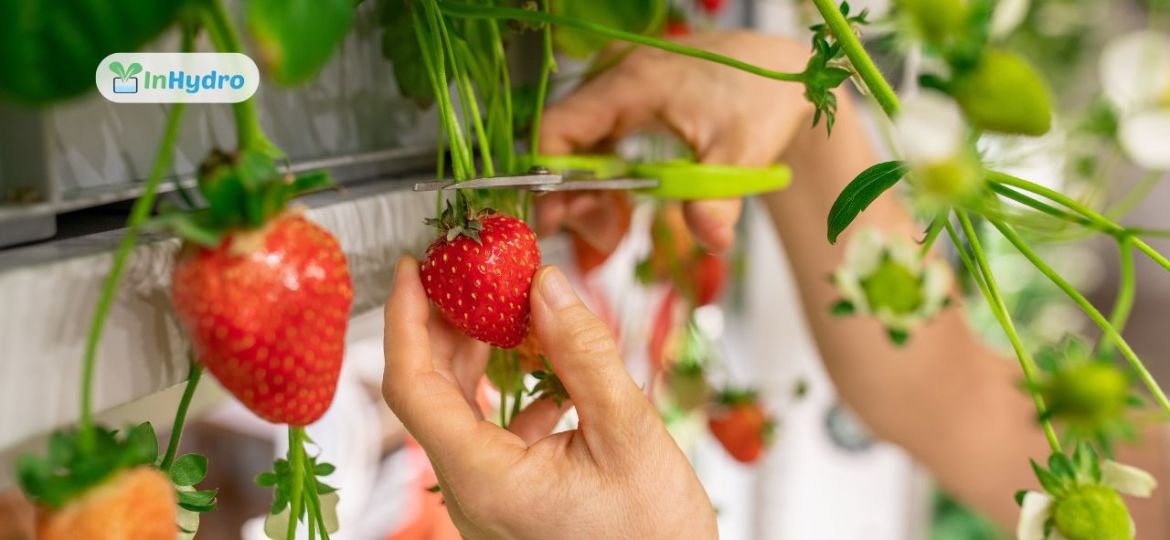
How to Grow Strawberries Hydroponically: Step-by-Step Guide
Strawberries are among the most profitable and high-demand fruits grown in hydroponic systems. With controlled conditions, these berries can be cultivated year-round, producing higher yields, better quality, and pesticide-free produce. This guide walks you through the step-by-step process of growing strawberries hydroponically, ensuring optimal growth, fruiting, and profitability.
Why Grow Strawberries Hydroponically?
Traditional soil farming of strawberries presents challenges such as pest infestations, inconsistent yields, and seasonal limitations. Hydroponic cultivation overcomes these issues by providing:
- Faster growth cycles with consistent nutrient availability
- Higher yield per plant due to optimized growing conditions
- Water efficiency – up to 90% less water usage than soil farming
- Pesticide-free production, ensuring cleaner, healthier fruits
- Vertical and space-saving options for urban and commercial farms
Choosing the Best Hydroponic System for Strawberries
Different hydroponic systems can be used for strawberries, depending on space, budget, and scalability:
1. Nutrient Film Technique (NFT)
- Thin film of nutrient-rich water continuously flows over plant roots
- Ideal for commercial production and stacked vertical farming
- Requires constant monitoring of water flow and oxygen levels
2. Dutch Bucket System
- Suitable for large strawberry varieties
- Uses drip irrigation and nutrient recirculation, reducing waste
- Ideal for greenhouse hydroponics and controlled environment agriculture (CEA)
3. Deep Water Culture (DWC)
- Strawberry roots are submerged in oxygenated nutrient solution
- Supports rapid growth and stronger root development
- Requires proper aeration and water temperature control
4. Vertical Tower System
- Maximizes space for urban and commercial hydroponic farming
- Uses a drip irrigation mechanism for efficient nutrient delivery
- Best for high-density strawberry cultivation
Step-by-Step Guide to Growing Hydroponic Strawberries
Step 1: Selecting the Right Strawberry Variety
Some strawberry varieties thrive better in hydroponic systems. Choose everbearing or day-neutral varieties for continuous fruiting.
Recommended Hydroponic Strawberry Varieties:
- Albion – High yield, large fruit size, and disease resistance
- Seascape – Ideal for NFT and vertical hydroponics
- Chandler – High sugar content and excellent flavor
- Monterey – High productivity and extended fruiting period
Step 2: Setting Up the Hydroponic System
- Choose a suitable location with proper light exposure (greenhouse, indoor farm, or shaded outdoor area).
- Install grow lights (LED full spectrum) if growing indoors. Strawberries need 12–16 hours of light per day.
- Set up the hydroponic system with proper support structures for vertical or horizontal growing.
Step 3: Preparing the Growing Medium
Strawberries do not grow well in standing water. Use a well-draining, aerated growing medium such as:
- Coco Peat – Retains moisture and supports root aeration
- Perlite & Vermiculite Mix – Enhances drainage and aeration
- Rockwool Cubes – Ideal for NFT and DWC systems
Step 4: Managing Nutrients and pH Levels
Strawberries require a balanced hydroponic nutrient solution to ensure high-quality fruiting.
Essential Nutrients for Hydroponic Strawberries:
- Nitrogen (N) – Promotes vegetative growth
- Phosphorus (P) – Supports root and flower development
- Potassium (K) – Essential for fruit quality and disease resistance
- Calcium (Ca) – Prevents fruit cracking and blossom-end rot
- Magnesium (Mg) – Improves photosynthesis efficiency
Ideal pH Level: 5.5 – 6.5
EC (Electrical Conductivity): 1.8 – 2.2 mS/cm
Step 5: Planting Hydroponic Strawberry Seedlings
- Start with healthy, disease-free strawberry seedlings instead of seeds for faster growth.
- Transplant them into the hydroponic system once they develop strong roots.
- Ensure proper spacing (8-12 inches apart) to allow air circulation and prevent mold growth.
Step 6: Optimizing Environmental Conditions
Hydroponic strawberries require specific environmental conditions for optimal fruiting.
Temperature:
- Daytime: 18–25°C
- Nighttime: 10–15°C
Humidity:
- 60–70% for healthy growth
- Use dehumidifiers in enclosed spaces to prevent fungal infections
Light Requirements:
- 12–16 hours of light per day
- If using artificial lighting, use LED grow lights with red and blue spectrum
Step 7: Pollination Techniques for Hydroponic Strawberries
Unlike soil-grown strawberries, hydroponic plants require manual pollination since they lack natural wind and insects.
Methods:
- Hand Pollination: Use a small brush to transfer pollen between flowers.
- Fan Circulation: Mimics wind movement for natural pollination.
- Bee Pollination: Introducing bumblebees in a greenhouse improves yield.
Step 8: Pest & Disease Management in Hydroponic Strawberries
Although hydroponic farming reduces pest risks, proper monitoring is essential to prevent infestations.
Common Issues & Solutions:
- Aphids & Spider Mites: Introduce natural predators like ladybugs or use neem oil.
- Powdery Mildew: Maintain proper air circulation and reduce humidity.
- Root Rot: Ensure proper aeration and avoid stagnant water in the system.
Step 9: Harvesting Hydroponic Strawberries
Strawberries typically mature in 5–7 weeks after flowering.
Signs of ripeness:
- Bright red color (depending on variety)
- Firm texture with a sweet aroma
- Easily detaches from the stem
Best Harvesting Practices:
- Harvest early in the morning for better shelf life.
- Use clean scissors to cut the berries, avoiding damage to the plant.
- Store strawberries at 2–4°C for extended freshness.
Key Benefits of Growing Strawberries Hydroponically
- Higher yields & year-round production
- Reduced water usage compared to soil farming
- Pesticide-free, clean, and safe produce
- Optimized space efficiency with vertical hydroponics
- Faster growth with controlled environment agriculture (CEA)
Conclusion
Hydroponic strawberry farming offers a sustainable, high-yield, and space-efficient solution for commercial and home growers. By choosing the right hydroponic system, maintaining optimal environmental conditions, and ensuring proper nutrient balance, growers can maximize fruit quality and yield. Whether for personal consumption, agribusiness, or urban farming, hydroponic strawberries represent a profitable and eco-friendly farming future.

